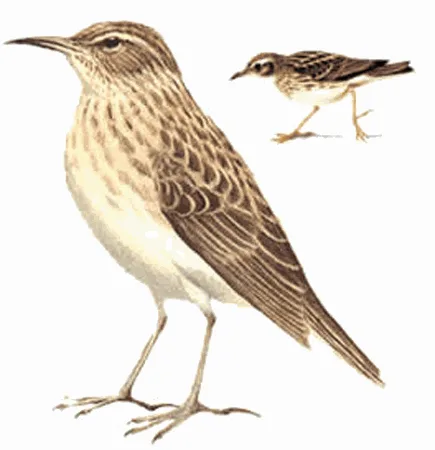
Duponts Lark
[order] PASSERIFORMES | [family] Alaudidae | [latin] Chersophilus duponti | [UK] Duponts Lark | [FR] Sirli ricoti | [DE] Dupontlerche | [ES] Alondra de Dupont | [NL] Duponts Leeuwerik
Subspecies
| Genus | Species | subspecies | Breeding Range | Breeding Range 2 | Non Breeding Range |
| Pseudalaemon | duponti | ||||
| Chersophilus | duponti | AF | n, also Spain | ||
| Chersophilus | duponti | duponti | |||
| Chersophilus | duponti | margaritae |
Physical charateristics
Small to medium-sized uncrested lark, with a quite long, decurved bill,a rather long neck, bulky body, and spindly legs. The folded wing-points of rather short, broad wings, almost entirely covered by the long tertials, do not extend down the tail as in most other larks. Plumage pattern much as Skylark but noticeably scaled or evenly fringed on scapulars and folded wing, copious streaks on head interrupted by pale crown-stripe, supercilium, eye-ring, and half-collar below cheeks. Ground-colour of plumage varies from dark brown to chestnut.
Unmistakable when seen well, but rufous race margaritae subject to risk of confusion with juvenile Hoopoe Lark when size, wing pattern, and plain chest of Hoopoe Lark obscured. When bill not visible, build may provoke confusion with crested larks Galerida but Dupont?s Lark lacks crest. Flight fast, with wing shape producing more flapping action than Alauda; normal flight and song-flight both end in sudden rapid perpendicular plunge, with flutter 2-3 m above ground. Prefers to escape by persistent running among ground cover. Inconspicuous except when singing and calling in first and last hours of daylight.
Unmistakable when seen well, but rufous race margaritae subject to risk of confusion with juvenile Hoopoe Lark when size, wing pattern, and plain chest of Hoopoe Lark obscured. When bill not visible, build may provoke confusion with crested larks Galerida but Dupont?s Lark lacks crest. Flight fast, with wing shape producing more flapping action than Alauda; normal flight and song-flight both end in sudden rapid perpendicular plunge, with flutter 2-3 m above ground. Prefers to escape by persistent running among ground cover. Inconspicuous except when singing and calling in first and last hours of daylight.
Listen to the sound of Duponts Lark
[audio:http://www.aviflevoland.nl/sounddb/D/Duponts Lark.mp3]
Copyright remark: Most sounds derived from xeno-canto
| wingspan min.: | 26 | cm | wingspan max.: | 31 | cm |
| size min.: | 18 | cm | size max.: | 21 | cm |
| incubation min.: | 0 | days | incubation max.: | 0 | days |
| fledging min.: | 10 | days | fledging max.: | 0 | days |
| broods: | 1 | eggs min.: | 3 | ||
| eggs max.: | 4 |
Range
Africa : North, also Spain
Habitat
Dupont’s lark is an endangered poorly known terrestrial passerine that occupies a wide altitude range and favours open spaces covered with dispersed low shrubs, most of which would be marginal for agriculture and are currently used for grazing.
Dupont’s lark Chersophilus duponti is restricted to steppe (dry, flat areas with low, scattered vegetation) areas of North Africa and Spain.
Dupont’s lark Chersophilus duponti is restricted to steppe (dry, flat areas with low, scattered vegetation) areas of North Africa and Spain.
Reproduction
The nest is build on the ground, set into tussock, hidden under bush, or sheltered by stone. The nest is scrape lined with available vegetation, including rootlets, fibres, small twigs, and hair. sometimes lining is hardly noticeable or even absent. Nest building took 3-4 days, clutch size was 4-5 eggs and incubation period was of 12-13 days.
Feeding habits
Mainly insects and small seeds. Feeds by using bill like woodpecker to dig into ground or into sandy bases of plant tufts and also by splitting open balls of horse dung.
Conservation
This species has not been well studied across much of its range, but moderately rapid declines are known to have occurred in some areas and are suspected elsewhere. Consequently it is classified as Near Threatened.
Chersophilus duponti occurs mainly in North Africa, but is also patchily distributed
in parts of north-eastern and south-eastern Spain. Its European breeding population
is relatively small (<15,000 pairs), and underwent a large decline between 1970-1990. The species continued to decline-albeit at a reduced rate-during 1990-2000, and the population probably underwent a small decline overall. Its population size clearly remains far below the level that preceded its decline.
This lark inhabits northern Africa, from Morocco to Egypt. It breeds also in Spain, where its population is estimated at 13000-15000 pairs, about half the world population of this species. Following transformation of its habitat through reclamation, irrigation, afforestation and disappearance of extensive livestock economy it is undergoing a certain decline
Chersophilus duponti occurs mainly in North Africa, but is also patchily distributed
in parts of north-eastern and south-eastern Spain. Its European breeding population
is relatively small (<15,000 pairs), and underwent a large decline between 1970-1990. The species continued to decline-albeit at a reduced rate-during 1990-2000, and the population probably underwent a small decline overall. Its population size clearly remains far below the level that preceded its decline.
This lark inhabits northern Africa, from Morocco to Egypt. It breeds also in Spain, where its population is estimated at 13000-15000 pairs, about half the world population of this species. Following transformation of its habitat through reclamation, irrigation, afforestation and disappearance of extensive livestock economy it is undergoing a certain decline

Migration
Resident Widespread in much of Spain. Very hard to locate.
Distribution map

